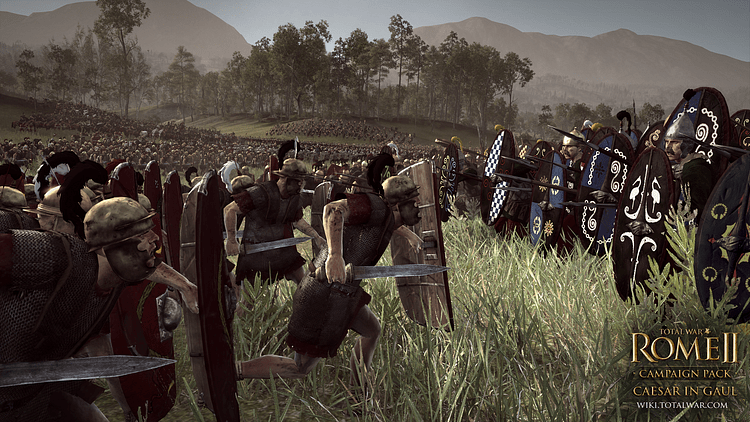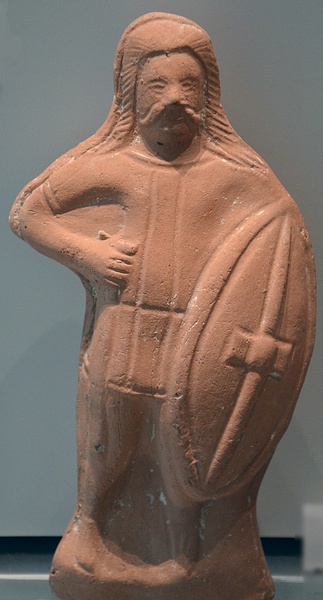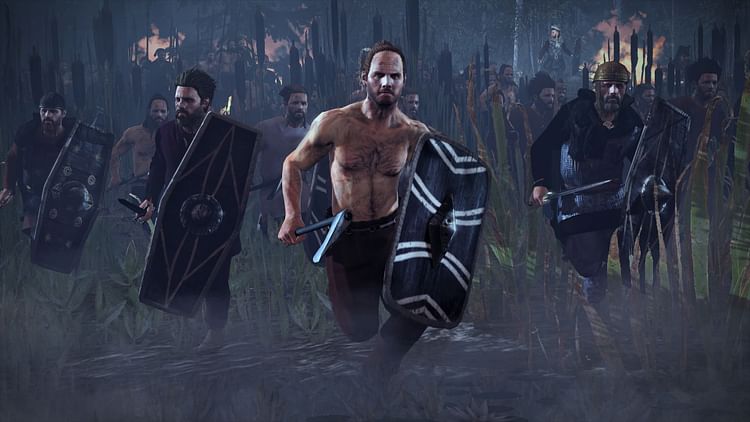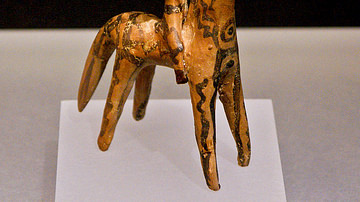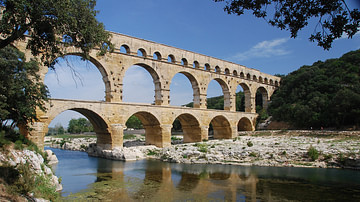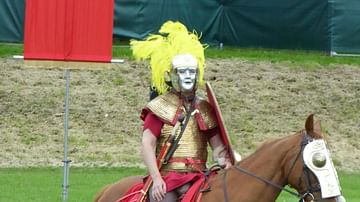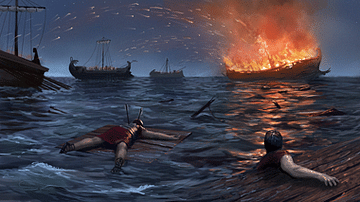Ever since the 4th century BCE, the Gallic tribes of northern Italy clashed with the expanding Roman Republic. In 225 BCE, the Boii forged alliances with fellow Gallic tribes of northern Italy and with tribes from across the Alps. The pan-Gallic army struck for Rome, but they were intercepted by three mighty Roman armies. Trapped at Cape Telamon, the outnumbered Gauls put up a hard fight but were ultimately defeated. The battle of Telamon marked the decline of Gallic fortunes in the war with Rome for northern Italy.
PROLOGUE
After burning and sacking Rome in 390 BCE, the Gallic tribes of northern Italy repeatedly clashed with the resurgent and expanding Roman Republic. Rome took the war to the Gauls and in 284 BCE vanquished the Senones and utterly devastated their lands (modern Romagna). The powerful Boii, who lived north of the Senones, in turn invaded the Roman heartland. The Boii suffered defeats, however, and in 282 BCE agreed to a peace treaty.
50 years passed before the Senones lands recovered sufficiently for the settlement of Roman citizens. The establishment of the Roman colony of Sena Gallacia along the coast worried the Boii, who justifiably feared further Roman inroads into Gallia Cisalpina (Gaul south of the Alps). A new generation of Boii had grown up, “full of unreflecting passion and absolutely without experience in suffering and peril” (Polybius, The Histories, II. 21). They were ready to renew the war with Rome. The Boii looked for help from Gallic tribes north of the Alps (Gallic Transalpina), but their first attempt ended in a quarrel during which two of the Transalpina kings were killed. In north-western Italy, however, the powerful Insubres were ready to fight with the Boii.
Together the Boii and Insubres sent ambassadors across the Alps, this time soliciting help from the Gaesatae who dwelt near the Rhone. The ambassadors enticed the Gaesatae kings Concolitanus and Aneroestus with tales of Gallic valor and gifts of gold, a small sample of what could be looted from the Romans. “On no occasion has that district of Gaul sent out so large a force or one composed of men so distinguished or so warlike,” wrote Polybius (Polybius, The Histories, II. 22).
Preparation for War
In 225 BCE, the Gaesatae crossed the Alps to join their allies - now including a contingent of Taurisci from the Alps' southern slopes - on the Po River plain. Not all the tribes of Gallia Cisalpina wanted war with Rome, though. The pro-Roman Veneti and Cenomani threatened the lands of the tribes marching off to fight Rome. The Boii coalition thus had to ensure that enough warriors remained behind to protect their homelands. Even so, the army that assembled was the biggest the pan-Gallic army ever to march on Rome, with over 20,000 cavalry and 50,000 infantry.
Unlike two centuries ago when Rome was sacked by the Gauls, Rome was no longer a mere city-state but a republic that had laid the foundation of an empire. After consolidating its hold on peninsular Italy, Rome emerged victorious in the First Punic War (264-241 BCE) and established itself as a major power in the Mediterranean. Tempered in battle with a myriad of nations, the Roman army had become bigger and better.
The threat of the Gallic army terrified all of peninsular Italy into raising tens of thousands of soldiers to aid the Romans. Allied Sabines, Samnites, Lucanians, Marsi and a host of other infantry and cavalry, joined the Roman legions. Over 150,000 men stood ready to fight under the Roman banner, stationed in three armies; in Etruria, on the Adriatic coast, and on Sardinia.
AMBUSH AT FAESULAE
The Gauls entered Etruria over a path in the northern Apennines Mountains. Having encountered no opposition, they plundered along the way to Rome. They were within three days of the city when their scouts reported that a large Roman army was behind them. It was the one from Etruria, and by sunset, it had drawn into the sight of the Gauls.
As both armies settled down to camp for the night, the Gauls contemplated what to do. The Roman army must have been of considerable size, for instead of offering battle the Gauls came up with a ruse. At night the Gallic infantry departed towards the nearby town of Faesulae. The cavalry remained behind at the campfires so that in the morning the Romans did not know where the Gallic infantry had gone. Assuming the latter had fled, the Romans advanced on the Gallic cavalry, which took off towards Faesulae. Following in pursuit, the Romans were ambushed by the Gallic infantry attacking out of the woods and shrubs near Faesulae. The Gallic cavalry now wheeled around so that the Romans were caught between infantry and cavalry.
The Romans were now in a real bind, but discipline and training paid off. The legions and their allies were able to carry out a fighting retreat. Although they suffered a loss of 6,000, the bulk of the army was able to reach a defensible position on a nearby hill. Here they fought off the Gauls, who, having slept little the night before, were further exhausted by fighting uphill. Unable to dislodge the Romans, the Gauls fell back and retired to recuperate from the fighting, leaving some cavalry to keep an eye on the Romans.
Meanwhile, Consul Lucius Aemilius Papus, commander of the Roman army on the Adriatic, got wind of the Gallic inroads and force-marched his men over the Apennines. He arrived just after the battle at Faesulae. As night was descending upon the land, Papus set up camp. His arrival naturally encouraged the Romans on the hill and, conversely, presented a major problem for the Gauls. Since the Gauls had already taken numerous slaves, cattle, and plunder, King Aneroestes of the Gaesatae thought that it would be wiser to return to their homelands with what they already had and return to deal with the Romans at a later date. Thus, at night, the Gallic army once again slipped away into the darkness. Blocked by the Romans to the north and by wooded hills to the east and west, the Gauls headed south.
The next day the two Roman armies combined and followed the retreating Gauls. When the terrain opened up at Lake Bolsena, the Gauls struck west for the Eturian coast. Once they reached the coast, they headed back north, hoping to reach the River Po and their homelands. The Roman army, just as cumbersome with its own supply train, draft animals, livestock, and hangers-on, followed in the Gallic army's wake.
CAPE TELAMON
By this time, the third Roman army from Sardinia had sailed north, past Corsica, and crossed to the mainland landing at Pisae. Probably at this point, the Roman army commander, Consul Gaius Atilius Regulus realized that the Gauls were no longer a threat to Rome but had taken captives and plunder and were trying to escape back to their homelands. Regulus marched south, hoping to intercept the Gauls. A Roman reconnaissance party scouted ahead and captured Gallic scouts who were forced to divulge the current position of their army. Regulus was pleased; the Gallic army would be squeezed and annihilated between two Roman armies. He ordered his tribunes to march forward in fighting order.
Between the Roman and Gallic armies, in the vicinity of Cape Telamon, a gentle hill rose beside the road. Eager to gain the hill before the Gauls, Regulus personally led his cavalry toward the hill. The Gallic army was still not aware of the new Roman threat from the north. Espying the Roman cavalry headed for the hill, the Gauls thought that they had been outflanked by Papus' cavalry coming from behind. The Gauls sent their own cavalry and light skirmishers to take the hill and took some prisoners in the fight. The prisoners told them the grim truth; they were about to get caught between two gigantic Roman armies.
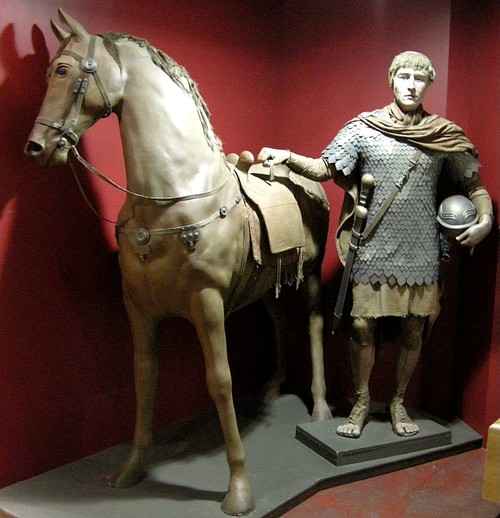
This time there was no escape for the Gauls. The Boii and Taurisci formed up to meet Regulus' army approaching from ahead. The Gaesatae and Insubres wheeled to face Papus' army coming up from behind. The Gallic chariots and wagons formed up on the flanks while a small detachment took the booty to the neighboring hills.
On the roadside hill, the cavalry melee raged on. Regulus was struck a mortal blow, and the macabre trophy of his head was carried back to the Gallic kings. The Gauls, however, had little time to gloat about Regulus' death for Papus' army forthwith arrived on the scene. Papus drew up his legions to face the Gauls and sent his cavalry to aid the Roman cavalry engaged on the hill.
The Roman infantry now sized up their foes. While they were well trained and armed, the Roman legionaries were citizens levied from the population during times of war. Though honor-bound to fight for Rome, they were not professional soldiers. To them, the enemy were savage barbarians.
[The Romans] were terrified by the fine order of the Celtic host and the dreadful din, for there were innumerable horn-blowers and trumpeters, and, as the whole army were shouting their war-cries at the same time, there was such a tumult of sound that it seemed that not only the trumpets and the soldiers but all the country round had got a voice and caught up the cry. (Polybius, The Histories, II. 29)
The tall, tawny, and red-haired Gallic warriors worked up their courage, shouting and gesturing with their spears, swords, and shields. The latter was their main defense, usually being oval and painted with swirling patterns. Many also wore bronze helmets, adorned with horns, plumes, or the Celtic symbol of war, the wheel. Only the chiefs and warriors of note boasted mail armor. Most wore the typical multicolored, checkered trousers and cloaks popular among the Gauls. Not so the Gaesatae, who in a show of courage and oneness with nature went into battle naked, wearing only their torques, armlets and bracelets.
The Roman consuls opened the battle with the light troops which streamed through the gaps of the maniples, the 60-120-men-strong primary tactical units of the Roman legions. Thousands of troops wearing wolf, badger, and other animals skins on their helmets, and carrying small round shields, hurled their small javelins upon the front rank of the Gauls. The spears and slings of the Gauls lacked the range to fire back, and so the Gallic warriors crouched behind their large shields while the deadly Roman missiles whistled among them. The naked Gaesatae suffered most of all. Enraged at their impotence, the bravest of them charged forward but were impaled by javelins before they could close in on their foes.
Trumpets blared, and the ground shook beneath the tramp of tens of thousands of legionaries as the maniples advanced upon the Gallic horde. The first manipli line, the hastati, unleashed another javelin volley upon the Gauls. The iron heads of their heavy pilum javelin were barbed and remained stuck in the Gallic shields. While the Gauls tried to pry the javelins out of their shields the hastati drew their short swords and charged.
The Gauls swung their powerful swords in great arcs, splintering shields, and biting into the bronze of the Roman helmets. The Romans, in turn, stabbed with their short swords. Needing less space per warrior, they presented a tighter shield wall. The Romans enjoyed the further advantage in that their oblong scutum, a shield bent backward, enclosing part of the bearer's body. Below the shield, the exposed forward Roman leg was protected by greaves. The hastati also wore breastplates while the second and third Roman lines, the principes and triarii, wore chainmail.
With skill, brute force, and courage, the outnumbered and surrounded Gauls held on. For a while it even looked like the battle could go either way. However, the cavalry battle on the hill had already ended in a Roman victory. The Gallic cavalry had fled, leaving the Roman horsemen free to come to the aid of their comrades on the plain below. Down the hill the Roman horses thundered, their spears slicing into the flanks of the Gallic infantry. The Gauls broke in panic but, hemmed in from all sides, were cut to pieces.
Aftermath
40,000 Gauls were killed and 10,000 captured for the slave markets. Among the captives was King Concolitanus. King Aneroestes escaped but overcome by grief ended up taking his own life. Papus sent the Gallic booty to Rome, to be returned to its owners. He then led his army towards the lands of the Boii to exact vengeance, burning and killing. Papus returned home to celebrate a Roman triumph, displaying his loot and captives.
In a series of campaigns that followed the battle at Telamon, the Romans shattered Gallic resistance in northern Italy. After the Roman victory at Clastidium, in 222 BCE, most of the Gauls submitted to Roman rule. Gallic resistance revived with Hannibal's invasion of Italy and continued for another ten years after the Second Punic War (218-201 BCE). The Boii were the last to give up in 191 BCE. Refusing to live under the Roman yoke, they wandered to the Danube region where they gave their name to Bohemia. Roman roads and colonies spread across Gallia Cisalpina, which by the mid-2nd century BCE had already become Italianized.
